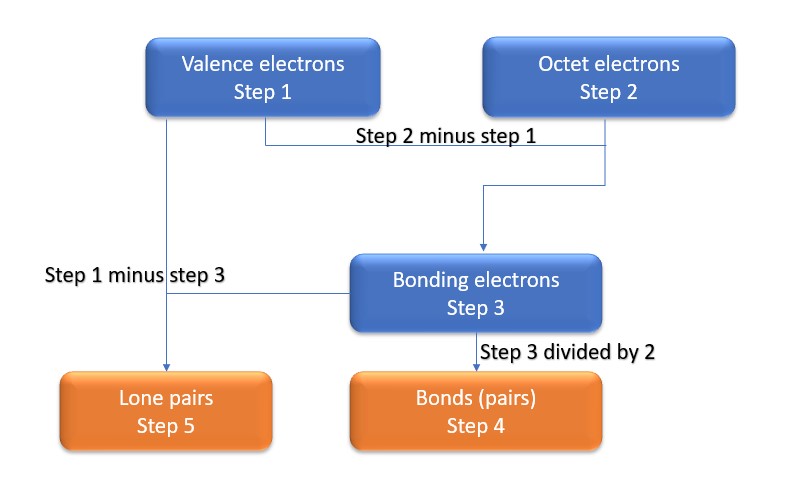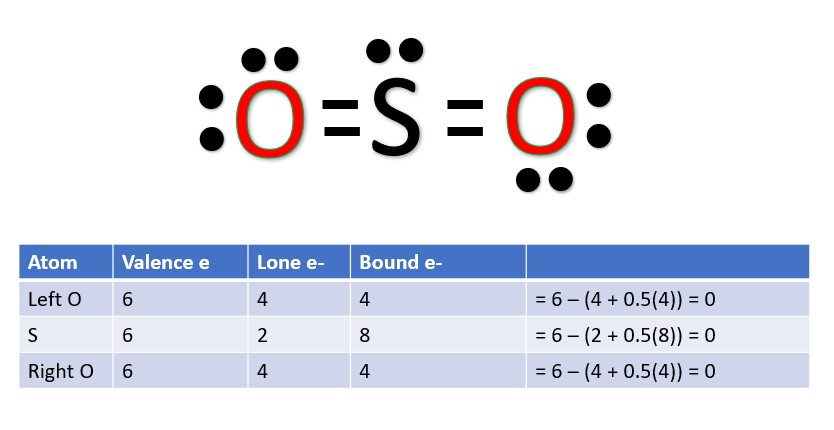What is the Lewis Structure of SO2?
What is the Lewis Structure of SO2? The Lewis structure has sulfur connected to two oxygen atoms by a double bond to each.
What is this molecule and what is it used for?
SO2, sulfur dioxide, is much more common in everyday life than you might think. SO2 is a gas which is a byproduct of burning fossil fuels, but is also used as a bleaching agent, in food preservation and as a refrigerant.
Method 1: Step method to draw the Lewis structure of SO2.
In this method, we find the bonds and lone pairs for the whole molecule, then plug it in to the atoms that we have to get the answer. Here is a little flow chart of how we are going to do this:

We will go through the steps below, but one thing to note here is that all the valence electrons (step 1) are either lone pairs OR bonding electrons. In other words…. Lone Pairs (Step 5) + Bonding electrons (Step 3) = Valence electrons (Step 1) . Let’s go through this example so we can see this a little more clearly.
Step 1: Find valence e– in all atoms. Add them together.
S=6
O=6 x 2
Total=18
Step2: Find octet e- for each atom and add them together.
S=8
O=8 x 2
Total=24
Step3: Gives you bonding e-. Subtract step 1 total from step 2
24-18=6e-
Step 4: Find number of bonds by diving the number in step 3 by 2(because each bond is made of 2 e-)
6e-/2= 3 bond pairs
Step 5: Find the number of nonbonding (lone pairs) e-. Subtract step 3 number from step 1.
18-6= 12e-=6 lone pairs
Now, use the information from step 4 and 5 to draw the Lewis structures. Remembering too (this is important):
Neutral sulfur has two bonds and two lone pairs
Neutral oxygen has two bond and two lone pairs
BUT THESE AREN’T GOING TO BE NEUTRAL!!
[Note: For more information on the natural state of common atoms, see the linked post here.]
We connect the sulfur and oxygens because they are the only two atoms in the molecule. Sulfur will be the central atom because it is the more electropositive.

However, this is not our final answer….if we look at the formal charge on each atom, we will see the following:
The formula for formal charge is FC = V – ( LP + .5 * BE) where FC (formal charge) is equal to V (# of valence electrons ) minus (lone electrons + half the bonding electrons). So, for our molecule, we see:

This is where knowing neutral oxygen is two lone pairs and two bonds comes in handy (so we can check ourselves on the calculations). Sincere there is a positive and negative charge on the same molecule, we should check to see if we can eliminate it. If we move one of the oxygen lone pairs to a bonding position, we still have an octet on oxygen but will have ten valence electrons on sulfur. This is OK because sulfur has d shells which can handle it. Let’s look at our formal charges now.

We see when we do this that there are no formal charges now and there are two double bonds from sulfur, along with the lone pair on sulfur.
So which Lewis Structure of SO2 is correct?
The answer is…technically both HOWEVER, your professors may take some points off for the structure with the charges, so you are definitely safer with the second one as your answer.
Another (easier) method to determine the Lewis structure of SO2:
Alternatively a dot method can be used to draw the Lewis structure.
Calculate the total valence electrons in the molecule.
S : 1×6 = 6
O : 2×6 = 12
Total = 18 valence electrons
Now, treat the atoms and electrons like puzzle pieces. We have to rearrange electrons to make sure everyone has an octet. We start with sulfur as the central atom because it is more electropositive, then attach two oxygen atoms. We make a double bond between each S and O to ensure octets (with sulfur having an octet of 10) and get our final answer.
PLEASE NOTE: We will still have the same issue with charges as above using this method.

Frequently asked questions:
Q: So what is the difference between the two methods?
A: In the first method, we are figuring out all of the lone pairs and bonds first, then placing those electrons and bonds on the atoms to form a molecule. In the puzzle method, we already have lone pairs and bonding electrons assigned to each atom, so all we need to do is push puzzle pieces together to get a molecule. In each method, we need to remember the “happy state” of each atom, ei hydrogen likes 1 bond and no lone pairs, uncharged carbon likes four bonds and no lone pairs ect.
And now some video:
This is a quick video we put together that visually demonstrates the two methods for Lewis structure and Lewis dot problems.
And finally, the Lewis structure study guide:
Here it is, this is our one-page guide to Lewis Dot and Lewis Structures:

